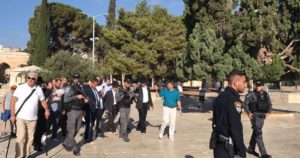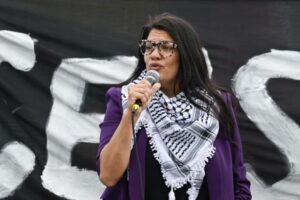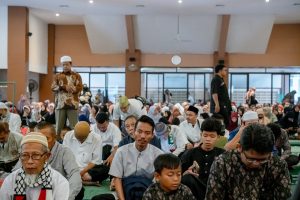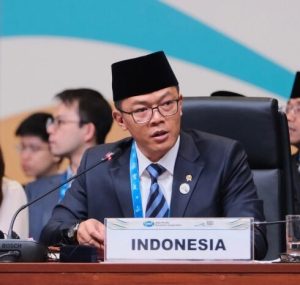By: Abdul Shaheed Drew at muslims-in-australia-since-the-1600s/" target="_blank">islaminaustralia.com
Before British Colonization
Growing up in Australia, the school curriculum teaches us that the Englishman Captain James Cook discovered Australia in 1770 (or at least it was the eastern side). Likewise one may hear a brief mention of the Dutch who made contact with the western and northern sides of Australia in the 17th Century. In any case when it came to history, national or international, we only heard of a selected Eurocentric version. Sad is the case when the rich history between the Indonesians and the Indigenous Australians is not given any mention in our school curriculum.
[A replica of Captain Cooks ship (The Endeavour) can usually be found docked beside the National Maritime Museum in Sydney. Ironically, inside the Museum, one can find a nice description of the Indonesian fishermen who visited Australia over one hundred years before Captain Cook. On display is an array of artefacts which the Indonesians left behind as proof of their frequent contact.]
Also Read: Nuclear Technology: Harm and Benefit from the Qur’anic Perspective
Muslim fishermen from Sulawesi Island in the Indonesian archipelago began collecting trepang (sea slug or sea cucumber) from Australias north as early as the mid 1600s. It was not until the 1700s and throughout the 1800s that the trepang trade was in full swing.
Although Indonesians did not begin fishing in Australia for trepang until the mid 1600s, it is obvious they were aware of this land well before that. However, we cannot put a particular date as to how early that was (e.g. 15th-16th Century). It was likely that the Dutch heard of the Land to the South through the Indonesians . The Yolngu who inhabited the north-eastern side of Arnhem Land had very early contact with the Macassans of Sulewesi. The Gowanese Sultanate of Southern Sulawesi incorporated Australias northern tip as land under the Kingdom of Gowa. A map of the extent of this kingdom which included Australias northern tip can be viewed in the Sultans palace in Makassar (see Makassar and Northeast Arnhem Land Missing Links and Living Bridges). The extent of that kingdom was suppressed when the Dutch took over and monopolized Gowas control on trade in the 1660s.
The two major tribes of Sulawesi where the Makassar and Bugis tribes. The trepang gatherers are commonly referred to as Makassans. Yet, there were considerable numbers of Buginese fisherman who frequented Australia.
The Makassans used to refer to Australia as the land of Marege. Every year they would travel to the land of Marege using the monsoon winds. In many cases Aboriginals would be hired by the Indonesian fisherman to assist in gathering trepang (sea slug or sea cucumber) in return for provisions. With the exception of a few isolated incidents, the ongoing contact was peaceful and positive. The native Aboriginals and their visitors from Sulawesi built a strong bond that lasted centuries. There were many cases of Aboriginals riding on the Praus (boats) to return with the Indonesians to Sulawesi Island. Additionally, many Makassan words were absorbed into the Aboriginal languages.
Also Read: Gaza Cries Out, the World Stays Silent: A Wounded Humanity
Places where trepang was prepared are visible til this day. These fishermen mostly remained on the coast. It is in these areas where they left behind many artefacts such as pots and crockery. The abundance of tamarind trees on Australias northern coast resulted from the seeds left behind by the Indonesians. Tamarind seeds would normally be used to flavour their rice. Amongst the tamarind trees are the wooden posts which mark the graves of Indonesians who past away on this land. After all of that, the indigenous Australians drew detailed cave and bark paintings giving descriptions of the of a significant history more Australians should be aware of.
After spending four months at a time they would gather tonnes of trepang. A good season could draw in 20 tonnes. Trepang would be gutted, dried out and smoked in temporary smoke houses on Australias coast. Chinese Junks would dock at the Port of Makassar on Sulewesi Island and purchase many tonnes of trepang from the Indonesians. Therefore, as Charles Campbell Mcknight put it, Australias first modern industry was trepang. It was conducted by brown-skinned MuslimsThe present pattern of Australian development has obscured these facts, so that many are surprised by the diversity of the continents history (Journey to Marege).
Australia eventually was colonised by the British in 1788. It was not until the late 1800s that the new colonial power sought to profit from the annual visitors to the north. Taxes were introduced and enforced along with licence restrictions for the praus. These restrictions had a significant effect, however, they did not put an end to the industry. By these measures both sides continued to benefit from the trepang industry. After a couple more setbacks, the final decision was made to halt the visits indefinitely on the 26th of July 1906. A letter was thus sent to Sulawesi to inform them that they will no longer be allowed to fish for trepang in Australian waters.
Also Read: Indo Defence Expo and Forum; Sharing Responsibility of Humankind and Environment
(P007/R04)
Mi’raj Islamic News Agency (MINA)
Also Read: Safiya Saeed: From Somali Migrant to First Hijab-Wearing Mayor of Sheffield

































 Mina Indonesia
Mina Indonesia Mina Arabic
Mina Arabic